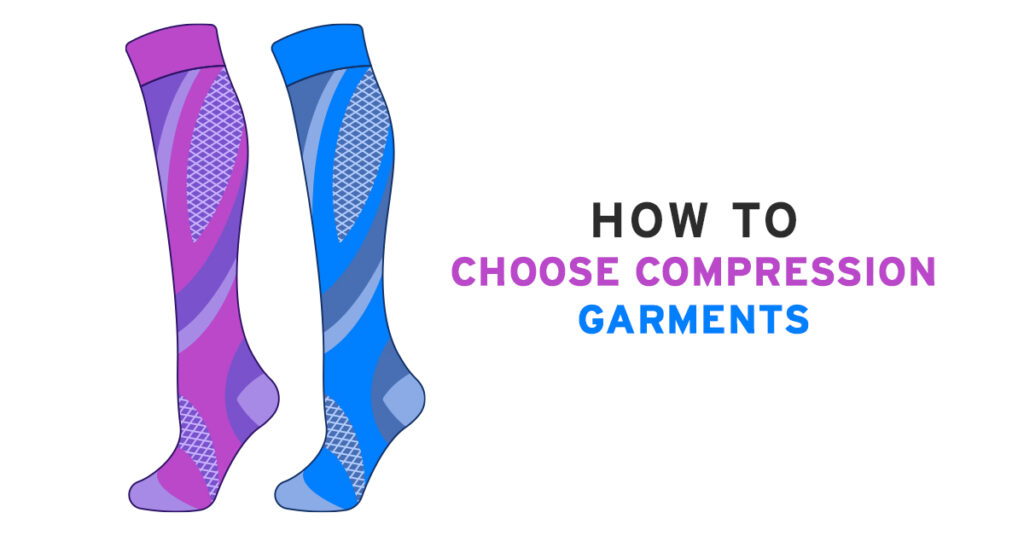Guest blog post written by Janelle Antonio DPT, CLT, PCES
I was 20 weeks pregnant, to the day. I looked down after watching a movie that night and thought to myself, “whose feet are those?!!” They were huge!
Lucky for me, I am a lymphedema therapist. This isn’t the case for most mamas. Most will call their friend or doctor and they hear, “get some compression socks.” Um…. but what kind? how do you figure out what to get?? You have all these great exercises your PT just gave you, but your legs are too heavy and painful by the end of the day to do them!
So, let's talk compression garments and the most common questions.
What size should you get?
Don’t just guess! Get a soft tape measure and look up the size grid for the socks you are considering. The most common measurements you’ll need are the smallest aspect of the ankle, and widest area of the calf. Don’t pull on the tape measure to get these measurements, just use a light “lay down” amount of tension.
What if my ankle and calf measurements fall into two different sizes?
Try a different brand! As with any clothing, different brands have different cuts, so look for one that will fit you the best.
What if my measurements seem to be between two sizes?
Size up! These aren’t easy to get on, and you’ll appreciate going a tad bigger as long as they are still appropriately sized.
What if my swelling is only in one leg?
Eeek! Go get checked out! Not to scare you – but to scare you just enough so you call the doctor today and don’t wait. Swelling during pregnancy is due to your venous system working sluggishly, and it affects both sides. If it’s only on one side, you want to get checked out to make sure it’s not a DVT (blood clot).
Do I really have to get those old lady knee highs??
No! There are so many fun designs to check out! (I personally like Sigvaris for some fun prints.) Also look for cotton ones if you don’t want shiny, sheer fabrics.
Should I get knee high, thigh high, or the pantyhose ones?
All depends on where your swelling is! Honestly, thigh highs and pantyhose are more of a hassle to wear, so people are less likely to wear them. Unless you are having heaviness or swelling in your upper thighs, I’d go for the knee highs.
You’ll see numbers on the box that indicate the level of compression. Medical compression grade is 20-30 mm/Hg. This is what is recommended 🙂
What about compression capris or leggings?
Who doesn’t love a pair of comfy leggings?! Our secret – I wore my maternity leggings until my twins were 3!! You want to be careful if there is compression in the leggings, though, because it’s harder to let fluid flow out of the feet and back up your legs, which can make swelling in your feet worse.
The compression ankle socks are much cuter, Janelle! Yes, and they aren’t bad; so if you want them, go for it; but do keep in mind that the fluid is having a hard time getting back up the leg, so compression to the knee is what is recommended for foot and ankle swelling.
Where do I buy these?
I’m sure the first place you are going to look is on Amazon (seriously, what did we do before Amazon??) You can find some great brands there, but beware that if they are too cheap, it could very well be too good to be true. I go with companies I can trust, so I usually stick with Juzo, Jobst, Medieven, Sigvaris, and WearEase.
A website I sometimes use is www.compressionguru.com
You have enough expenses, so see if your insurance covers them! Call the number on the back of your card or look up your policy online. If so, you can order through a company such as Comfort Care or Caring Touch Medical. (No financial gain here, these are just two that I have used before.) Some pharmacies will also order them for you. Just know exactly what you want before you call!
Things to note after you get them:
They may seem too tight…. I’m not going to lie, these are tight; but if your measurements line up with the size chart, it’s the right fit for you. You may need someone to help you put them on. My hubby had to help me every morning in the last couple of months of my pregnancy. Do keep in mind that if these are garments you bought months ago, there is a chance that despite all your efforts your legs may be getting bigger, and you may need a different size.
Do not sleep in these! These are for daytime wear only! Get them on when you first wake up, though. Compression garments are intended to prevent swelling from occurring, not to push swelling out; so you want to get them on early in the day.
They should not cause pain, but reduce pain!
Research does not indicate that compression garments increase core body temperature, but if you tend to overheat easily and the garments seem to contribute to that with a body temp >100.4 deg F, please remove them. This is a temperature indicated in the literature, but talk with your physician on what degree you personally should note as one of concern.
Research shows that pain, edema, varicosities and feelings of heaviness in the legs all have a significant reduction when wearing compression garments. If you are a research nerd like me, here is a good study to check out→
- Saliba O, Rollo H, Saliba O et al. Graduated compression stockings effects on chronic venous disease signs and symptoms during pregnancy. Phlebology 2020; Vol 35 (1) 46-55
You can find out more about Janelle using the links below:

